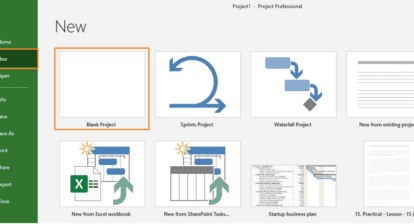The release of Service Pack 1 for Project Server 2010 and Microsoft SharePoint marks a major milestone in the product development lifecycle. All fixes prior to the June 2011 Cumulative Update (CU) are included in SP1. In addition, there are some key enhancements included in SP1 that users will appreciate, from new browser support to site storage metrics. In this article I cover seven of the most interesting and useful updates.
Download a full list of updates on the Microsoft site.
1. Multi-browser Support
Service Pack 1 delivers multi-browser support for some of the key Team Member Project Web App (PWA) pages: My Tasks, Timesheet, and Issues and Risk. Your users can now view these pages on Firefox, Chrome on PC and MacOS, and Safari on MacOS.
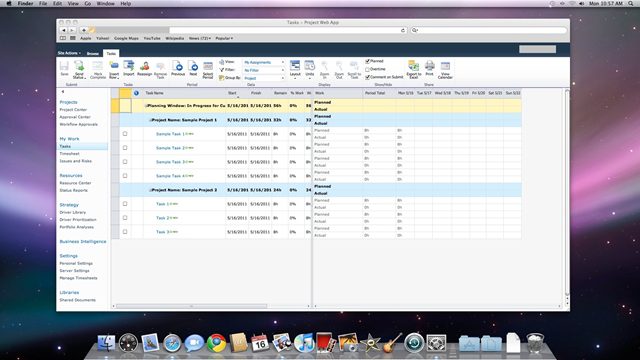
Notes:
- Safari and Opera on Windows PC aren’t supported.
- Linking Risks & Issues to Project tasks isn’t supported.
- Available with both SP1 and the June 2011 CU.
2. Time-phased Support for Manually Scheduled Tasks
With this enhancement, you can now edit time-phased data for manually scheduled tasks within Project Professional, PWA, and Project Server. For example, you can edit work values in the project Task Usage view or report time-phased data in task statusing for manually scheduled tasks via My Tasks or Timesheets.

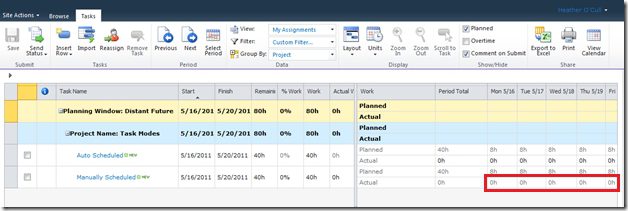
Notes:
- To use this feature, set the server feature, “Manually scheduled tasks can be published to team members.”
- Available with both SP1 and the June 2011 CU.
3. Auto-scheduled Project Task Synch to SharePoint
Previously we could only synch manually scheduled project tasks to SharePoint. Now we have the ability to synch automatically scheduled tasks as well. Other enhancements include performance improvements and the ability to do a Project Task synch to SharePoint 365!
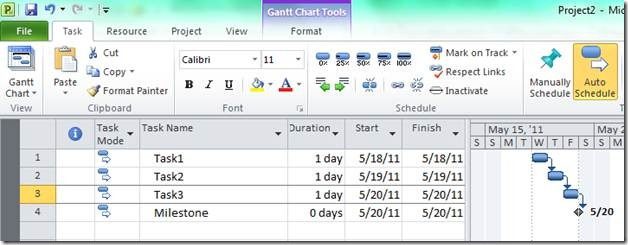

Notes:
- The synch feature is only available with Project Professional and not available in the Standard version.
- Only Finish-to-Start task dependency is supported. If the Project tasks have other dependency types, then you’ll receive a warning message.
- Also, there’s no option for selecting which task, summary task, or milestone gets published to SharePoint. It’s all or nothing.
- Available with the June 2011 CU only.
4. Improved PWA Project Scheduling
Enterprise Project Managerment (EPM) 2010 brought the convenience of a browser-based project editing solution together with the power of the desktop client. A limitation though was that the only way to edit projects that contained Fixed Work or Effort Driven tasks was to use Project Professional 2010. This full planning capability didn’t make it in the release-to-manufacturing (RTM) version of Project Server 2010.
With SP1, you can now edit project plans containing Fixed Work tasks and Effort Driven tasks in Project Web App.
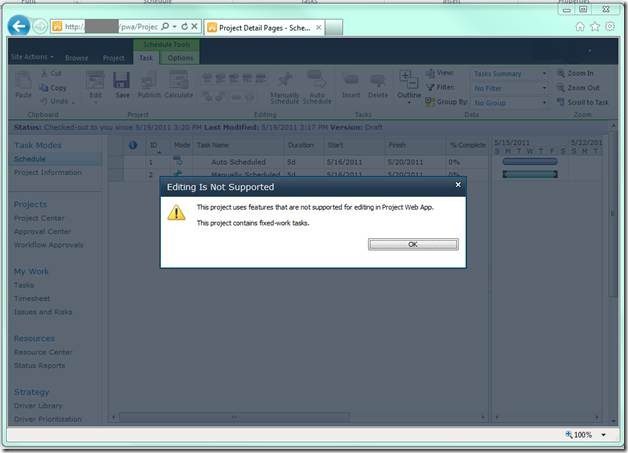
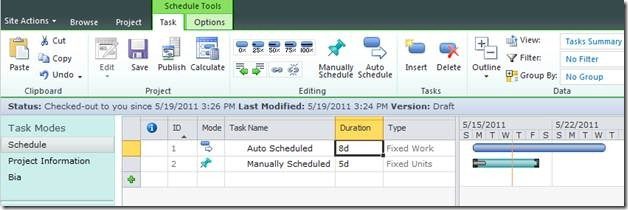
Notes:
- Observe the limitations of PWA project planning & scheduling capabilities; for example, don’t expect it to handle complex dependency management within or across projects. Use Project Professional as appropriate.
- Available with both SP1 and the June 2011 CU.
5. Auto Publish Approved Task Updates
Pre-SP1, if you had a rule set up to accept the task updates automatically, you then had to manually publish the updates/project or you needed code to launch an event to automate this process. SP1 introduces a new enhancement for automatically publishing approved task updates.
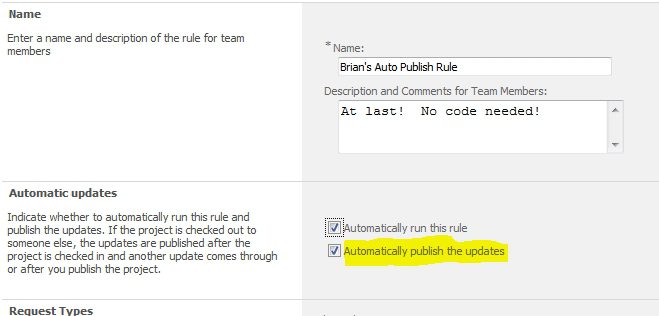
Notes:
- June 2011 CU has a further fix.
- Available with both SP1 and the June 2011 CU.
6. Site Recycle Bin
Ever accidentally deleted a site and wished you could recover it? The SharePoint RTM version has recycle bins at site and site collection levels that allow users to recover all deleted items contained within a site. If, however, a site is deleted, you needed to rely on a SQL database backup to be restored and recover the site. Going the hard way would have involved your IT and SQL DBA teams. Oops!
With SP1, the site collection (SC) Recycle Bin capability has been enhanced to enable recovery of deleted sites in addition to other deleted items you could recover before.


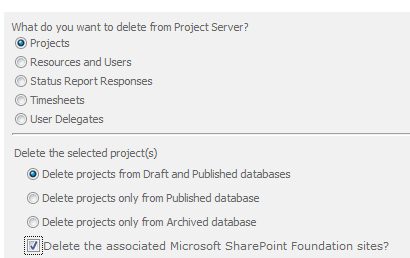
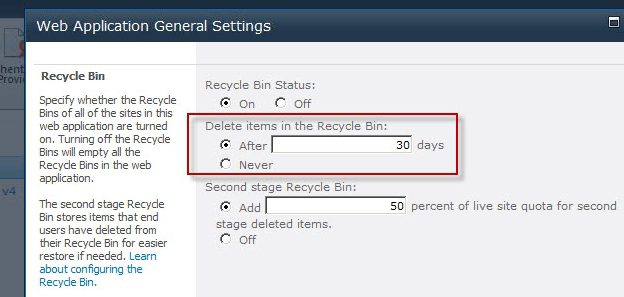
Notes:
- Remember: This is a SharePoint enhancement. Project Server administrators still need to take care when deleting associated SharePoint sites via the Project Server interface as these deleted sites won’t be captured by the SC Recycle Bin. You may wish to manually do this via SharePoint Site Settings, which would give you the option to restore from the Recycle Bin should the need arise.
- By default, items in the Recycle Bin are deleted automatically after 30 days. Regardless of whether or not an item is sent to the user’s Recycle Bin or to the Site Collection Recycle Bin, items are deleted automatically after the number of days that the central administrator has specified.
- Available with both SP1 and the June 2011 CU.
7. Site Storage Metrics
This new feature provides an overview of the storage being used by the sites and folders within a Site Collection. It allows administrators to see which sites are storing too much data or which sites are breaching their quota and need archiving.
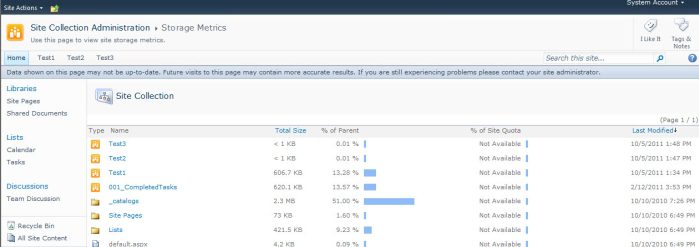
Notes:
- This feature is available to Collection Administrators only.
- Available with both SP1 and the June 2011 CU.
In my next article, I’ll lay out a basic plan for you to follow in implementing Service Pack 1.




